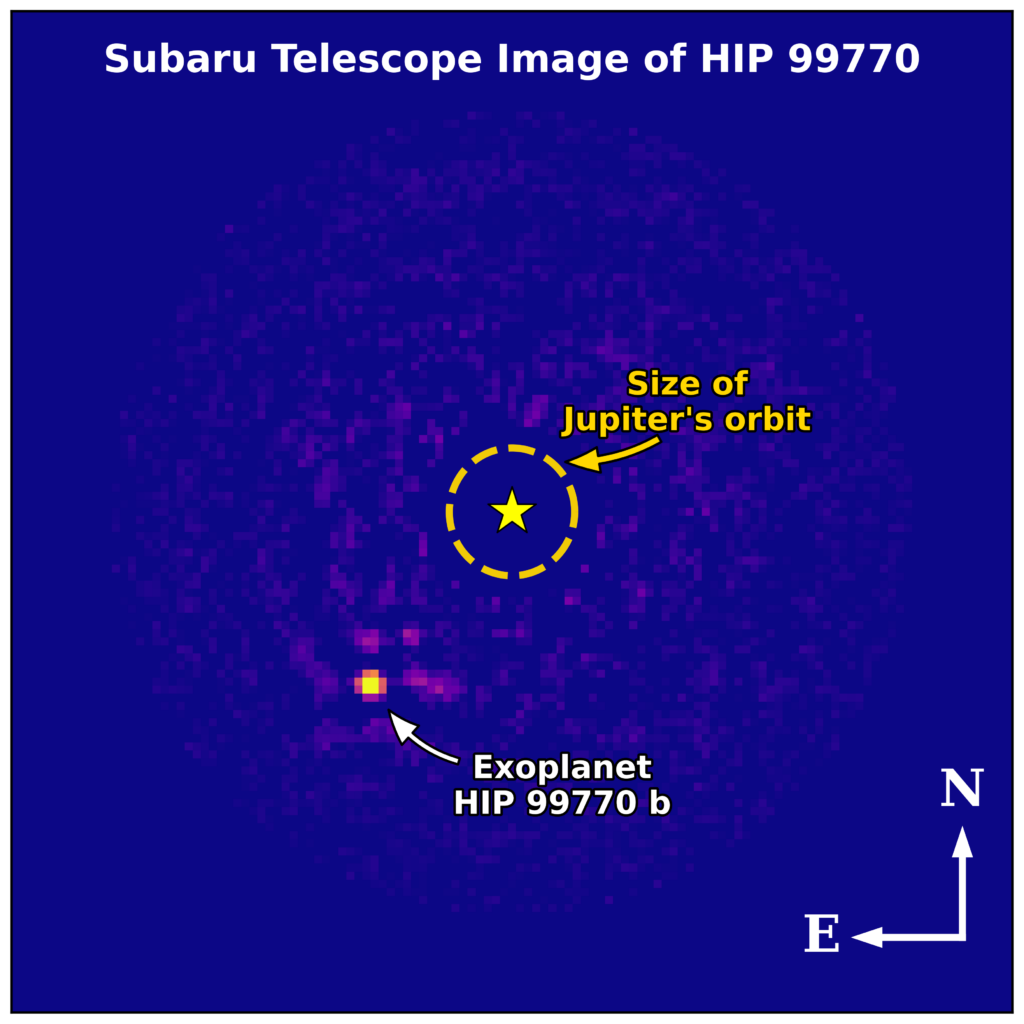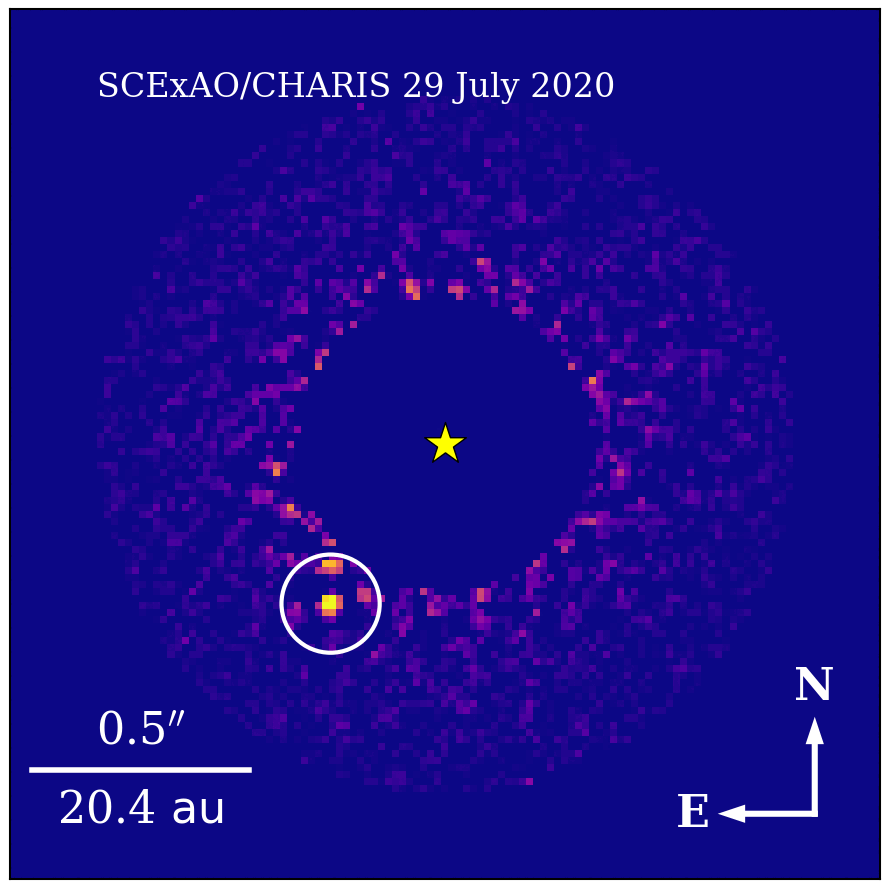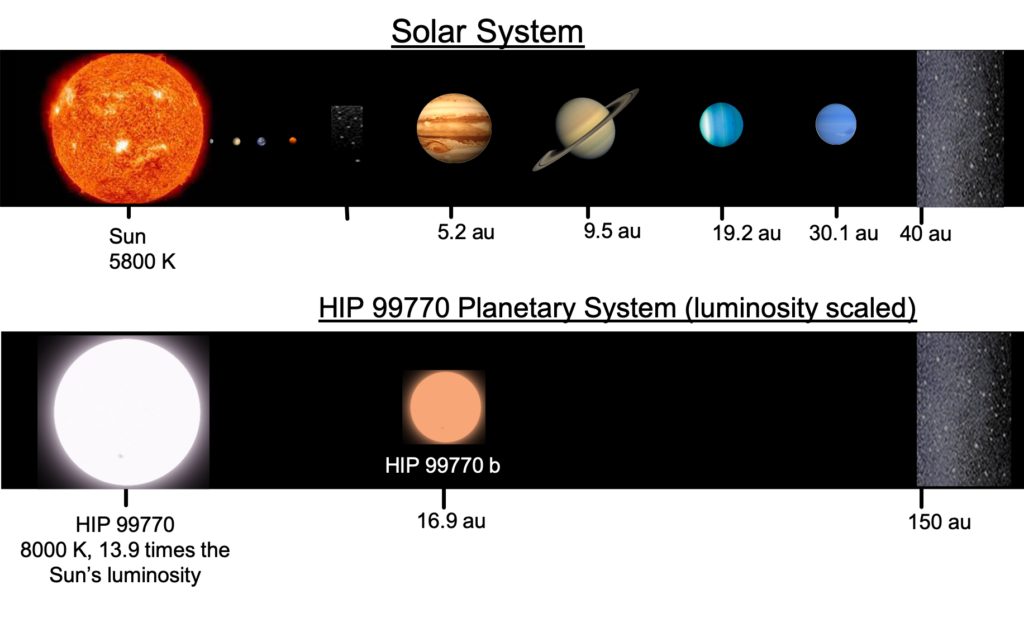In a breakthrough discovery, the Subaru Telescope’s powerful extreme adaptive optics system has imaged a massive benchmark gas giant planet around the nearby, bright star HIP 99770. The object, HIP 99770 b, is the first extrasolar planet jointly discovered by direct imaging and the new method of indirect detection, precision astrometry. This new approach for finding imageable planets simultaneously measures their weight, orbits and even their atmosphere. It prefigures the way that we will someday identify and characterize an Earth twin around a nearby star.

“We are now in a new era for imaging other worlds,” says Thayne Currie, lead author of the ground-breaking paper published in Science.
Direct imaging is a method that will someday reveal an Earth-like exoplanet around a nearby star. In the past 14 years, large ground-based telescopes equipped with adaptive optics (AO) to sharpen starlight have taken key steps towards this goal, revealing the first direct images of Jupiter-like gas giant exoplanets. These discoveries draw from so-called blind surveys: targets are selected based on system properties like age and distance but are otherwise unbiased. Unfortunately, the low yields of these blind surveys show that exoplanets we can image with current telescopes are rare.
Direct imaging searches focused on stars showing dynamical evidence for a planet may greatly increase the rate of imaging discoveries. Precision astrometry — measuring the position and motion of stars on the sky — could identify which stars are being pulled by the gravitational influence of an unseen companion and thus may host planets we can image.
An international research team led by Subaru Telescope, the University of Tokyo, the University of Texas-San Antonio, and the Astrobiology Center of Japan report the world’s first joint direct imaging and astrometric discovery of an exoplanet, using Subaru Telescope’s extreme adaptive optics system (SCExAO; Note 1) coupled with its near-infrared spectrograph (CHARIS) combined with astrometry from European Space Agency’s Gaia mission and its predecessor, Hipparcos. The planet was imaged around the nearby bright star HIP 99770, located in the constellation Cygnus.

“Once we knew which star to look at, Subaru’s extreme adaptive optics system was able to sharpen starlight so well that our infrared instruments could see the faint planet hinted at by Gaia and Hipparcos” notes Olivier Guyon, the Principal Investigator of SCExAO.
The planet – HIP 99770 b – is about 100,000 times fainter than the star it orbits. Its CHARIS spectrum, combined with follow-up imaging from the W.M. Keck Observatory, reveals an atmosphere shaped by water and carbon monoxide, with a temperature about 10 times hotter than Jupiter’s. Its atmosphere resembles an older and slightly less cloudy counterpart to the atmospheres of the first imaged planets, HR 8799 bcd.
By jointly analyzing data from the Subaru Telescope, Keck, Gaia and Hipparcos, the team was able to directly measure the planet’s mass and constrain its orbit. HIP 99770 b is about 14-16 times the mass of Jupiter in our own Solar System, and orbits a star that is nearly twice as massive as the Sun. The planet’s orbit is three times larger than Jupiter’s around the Sun or just over half of Neptune’s distance from the Sun. However, it receives nearly the same amount of light as Jupiter because it’s host star is far more luminous than the Sun.
“Combining direct imaging from Subaru and Keck with precision astrometry tells us far more about planets like HIP 99770 b than was previously possible,” says Currie.

The discovery has broader implications for the field of extrasolar planets. HIP 99770 b was detected as a part of a SCExAO direct imaging program using Gaia data to identify stars being gravitationally pulled by unseen planets. While many results are currently unpublished, their detection rate so far appears much higher than from previous blind surveys.
“This approach is a better way to find planets that we can then image and study in detail. As our instruments are improving, more will be found,” says Guyon.
The combined approach will also allow us to find an Earth-like planet around a nearby star with upcoming ground-based observatories like the Thirty Meter Telescope or space-based ones like the Habitable Worlds Observatory. Such a planet will be much closer to its star than any planet imaged to date and so will spend a large amount of time either in front or behind that star, making it impossible to see.
“The indirect detection method will point us to a star around which a rocky, terrestrial planet could be imaged. Once we know when to look, we hope to learn whether this planet has an atmosphere compatible with life as we know it on Earth,” says Motohide Tamura, Professor of the University of Tokyo.
The Subaru Telescope and the W. M. Keck observatory are located at the summit of Maunakea in Hawai`i, an inactive volcano known for its unsurpassed qualities as an astronomy site and its deep personal and cultural significance to many Native Hawaiians.
“Maunakea is the best place on the planet Earth to see other worlds. We are extremely grateful for the privilege of being able to study the heavens from this mountain,” says Currie.
These results appeared as Currie et al. “Direct Imaging and Astrometric Detection of a Gas Giant Planet Orbiting an Accelerating Star” in Science on April 13, 2023.
(Note 1) With ground-based telescopes, the images of celestial objects appear out of focus and shaky, as if looking out from underwater, due to the effects of the Earth’s atmosphere. Extreme adaptive optics corrects the turbulence caused by the Earth’s atmosphere in real time with exceptional precision, making the Subaru Telescope produce extremely sharp images.
The Subaru Telescope is a large optical-infrared telescope operated by the National Astronomical Observatory of Japan, National Institutes of Natural Sciences with the support of the MEXT Project to Promote Large Scientific Frontiers. We are honored and grateful for the opportunity of observing the Universe from Maunakea, which has cultural, historical, and natural significance in Hawai`i.
(Related Links)
NAOJ April 14, 2023 Press Release
Subaru Telescope April 13, 2023 Press Release
The University of Tokyo April 14, 2023 Press Release
The University of Texas-San Antonio April 13, 2023 Press Release

